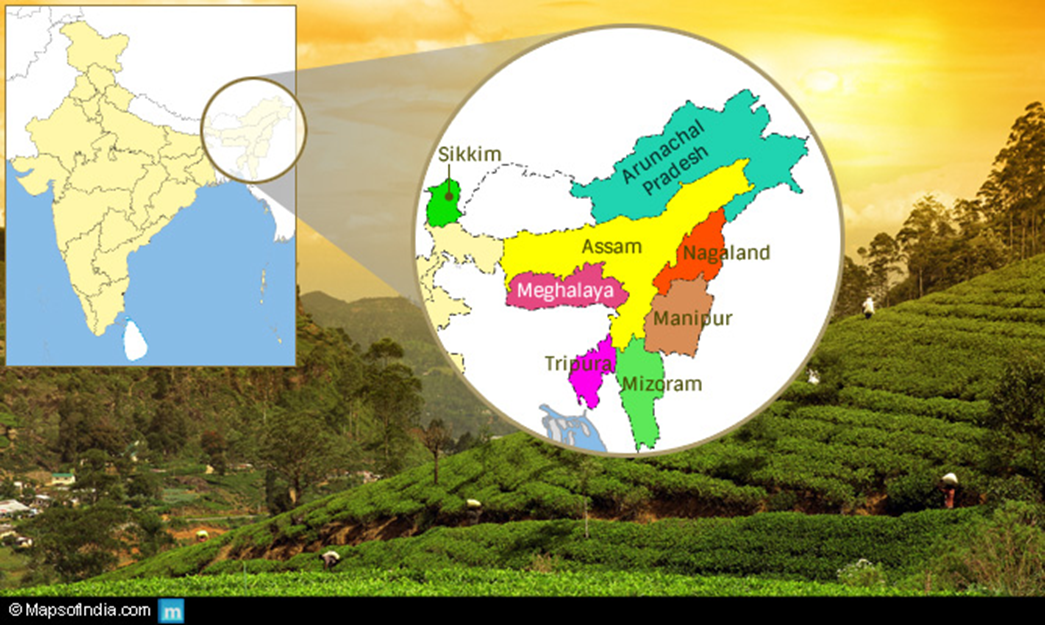Description

Copyright infringement not intended
Picture Courtesy: MapsofIndia.com
Context: The Union Cabinet has approved the continuation of the North East Special Infrastructure Development Scheme (NESIDS) with a budget of Rs. 8139.50 crore from 2022-23 to 2025-26. The scheme consists of two components: NESIDS-Road and NESIDS-Other Than Road Infrastructure (OTRI).
Details
- The primary objective of NESIDS is to facilitate infrastructure development, particularly connectivity, in the North Eastern States. The Cabinet also approved the continuation of the 'Schemes of NEC' for the same period (2022-23 to 2025-26), with a total budget of Rs. 3202.7 crore.
- The schemes under the Ministry of Development of North Eastern Region (MDoNER) serve to complement the efforts of various Central Ministries and Departments as well as address the specific needs of the North Eastern States.
- These schemes aim to bridge development and welfare gaps by supporting projects that enhance connectivity, address social sector deficits, and boost livelihood and employment opportunities in the region.
- The scheme is fully funded by the central government and will support projects in sectors such as power, water supply, health, education, tourism, agriculture and allied sectors.

North East Special Infrastructure Development Scheme (NESIDS)
About
- It is a central sector scheme launched by the Ministry of Development of the North Eastern Region, aimed at benefiting all the North Eastern states of India.
- It focuses on bridging infrastructural gaps in the region, covering both physical and social infrastructure aspects.
- The primary objective of NESIDS is to promote inclusive development. By focusing on bridging developmental gaps and fostering growth opportunities, the scheme aims to ensure that no region within the North East is left behind.
Features
- Central Sector Scheme: NESIDS operates as a central sector scheme, meaning 100% of the funding comes from the Central Government. This ensures consistent and dedicated financial support for the development projects.
- Comprehensive Infrastructure Coverage: The scheme has a broad focus, encompassing both physical and social infrastructure. It covers various sectors such as water supply, power connectivity, tourism-related projects, education, and health. This comprehensive approach addresses the diverse developmental needs of the region.
- Supplementary Support: NESIDS complements the existing schemes of the Central and State governments in the North East. It provides additional funding to address specific infrastructure gaps and developmental challenges that might not be fully covered by other schemes.
- Beneficiaries: All eight North East Indian states – Arunachal Pradesh, Nagaland, Manipur, Mizoram, Tripura, Meghalaya, Assam, and Sikkim – are direct beneficiaries of NESIDS. The scheme is tailored to address the unique development requirements of each of these states.
- Targeted Financial Assistance: NESIDS extends financial assistance to projects that are not covered by any other central or state government schemes. This ensures that critical projects, which might otherwise face funding constraints, receive the necessary implementation support
Implementation
- Funds Allocation: The allocation of funds under NESIDS follows a normative allocation approach, with funds being disbursed to states at the beginning of the financial year. This ensures a planned and systematic distribution of resources for development projects.
- Project Completion: NESIDS provides funds for ongoing projects that are part of the North Eastern Region's Non-Lapsable Central Pool of Resources (NLCPR). These funds are intended to support the completion of projects within a specified timeframe, enhancing their effectiveness and impact.
- Performance-Based Approach: States that are unable to effectively utilize their allocated funds may have their funds redirected to states that are demonstrating better performance in implementing NESIDS projects. This approach ensures optimal utilization of resources and encourages efficient project execution.
- Eligibility for Funding: NESIDS funding is reserved for projects that do not receive support from any other central or state government scheme. This criterion ensures that the scheme targets projects with unmet developmental needs, preventing duplication of funding and maximizing the impact of resources.
Significance
- Focused Development: NESIDS plays a pivotal role in channelling dedicated development efforts towards the North Eastern region by providing essential financial assistance for various infrastructure projects.
- Enhanced Infrastructure: The scheme significantly contributes to the enhancement of physical infrastructure, encompassing crucial aspects such as improved power connectivity, water supply systems, and the development of tourism-related projects.
- Social Welfare: NESIDS has a substantial impact on the improvement of social infrastructure within the region. It focuses on strengthening education and healthcare sectors, which directly enhances the overall well-being and quality of life of the people in the North Eastern states.
- Promotion of Inclusive Growth: By addressing existing infrastructural gaps, NESIDS catalyzes fostering balanced growth and development across different regions of the country. It ensures that the North Eastern states are not left behind in the nation's journey towards progress.
Challenges
- Geographical Constraints: The North Eastern region's challenging terrain, characterized by hills, forests, and rivers, can make the execution of infrastructure projects difficult and costly due to construction complexities and accessibility issues.
- Human Resource Development: Developing a skilled workforce capable of planning, implementing, and managing infrastructure projects is crucial. The region may face challenges in sourcing and retaining skilled professionals.
- Environmental Concerns: While development is essential, ensuring environmental sustainability is equally important. Balancing infrastructure growth with the preservation of the region's unique biodiversity and natural ecosystems poses a significant challenge.
- Funding and Financial Management: Ensuring the optimal utilization of funds and efficient financial management for project execution can be challenging, especially when dealing with large-scale infrastructure initiatives.
- Stakeholder Engagement: Involving local communities and stakeholders in the planning and execution of projects while addressing their concerns and aspirations requires effective communication and coordination.
- Project Monitoring and Maintenance: Monitoring the progress of projects and ensuring their long-term maintenance and sustainability can be challenging in remote areas with limited resources.
Addressing these challenges is essential to maximize the positive impact of NESIDS and ensure that the development efforts contribute effectively to the growth and well-being of the North Eastern region and its people.
Way Forward
- Detailed Planning: Create detailed development plans that incorporate the enhancement of connectivity through road, rail, and air networks. Identify key infrastructure projects and prioritize them based on their potential impact on trade, tourism, and overall development. Develop a timeline and allocate resources accordingly.
- Skill Development Framework: Establish a comprehensive skill development framework that addresses the specific needs of the region. Collaborate with educational institutions and industry experts to design training programs that equip individuals with the necessary skills for project implementation and sustainable growth. Regularly update these programs to stay relevant to changing demands.
- Environmental Impact Assessment: Before implementing any development projects, conduct thorough environmental impact assessments. Identify potential risks to the ecosystem and develop mitigation measures to minimize negative effects. Ensure that projects adhere to environmentally friendly practices and adhere to regulatory guidelines.
- Public-Private Partnership Agreements: Formulate clear and transparent agreements with private sector partners. Define roles, responsibilities, and expectations to ensure smooth collaboration. Foster an environment of innovation by encouraging private sector partners to bring their expertise and resources to the table.
- Community Participation: Engage local communities from the early stages of project planning. Conduct consultations, workshops, and information sessions to gather their input and address their concerns. Incorporate local knowledge and preferences into project designs to ensure that they align with the community's needs and values.
- Monitoring and Evaluation: Implement a robust monitoring and evaluation system to track the progress and impact of development initiatives. Regularly review the outcomes against the established goals and make necessary adjustments. This data-driven approach will help identify successful strategies and areas for improvement.
- Capacity Building: Invest in building the capacity of government agencies and relevant institutions responsible for project implementation and oversight. Equip them with the skills and knowledge required to manage complex development projects effectively.
- Stakeholder Communication: Maintain open and transparent communication with all stakeholders, including government bodies, private sector partners, local communities, and the general public. Keep them informed about project updates, challenges, and achievements.
- Flexible Adaptation: Remain flexible and adaptable to changing circumstances and emerging opportunities. Development is an ongoing process, and the ability to adjust strategies in response to new developments is crucial.
- Long-Term Vision: Keep a long-term perspective in mind. Development efforts may take time to yield substantial results. Maintain a commitment to the overarching vision of sustainable and inclusive growth.

Conclusion
- NESIDS is a crucial step towards addressing infrastructural gaps and fostering comprehensive development in the North Eastern states. India's focus on both physical and social infrastructure, along with addressing challenges through strategic approaches; will contribute to the region's progress and inclusivity.
Must-Read Articles:
SCHEMES FOR DEVELOPMENT OF NORTH-EAST: https://www.iasgyan.in/daily-current-affairs/schemes-for-development-of-north-east
15TH FINАNСE СОMMISSIОN AND ITS RECOMMENDATIONS: https://www.iasgyan.in/blogs/abc
|
PRACTICE QUESTION
Q. What is the significance of maintaining a balance between the economy and the environment in the NorthEast region, and what challenges does this region face in achieving this balance? What potential ways forward can be pursued to ensure sustainable development that benefits both the economy and the environment in the North East?
|
https://pib.gov.in/PressReleasePage.aspx?PRID=1950889









